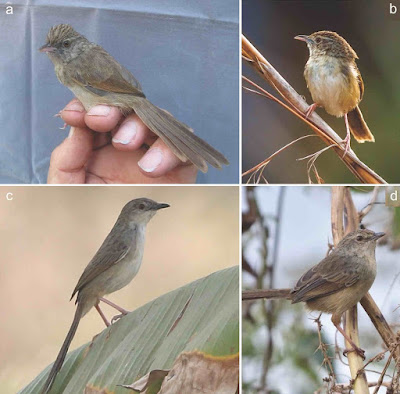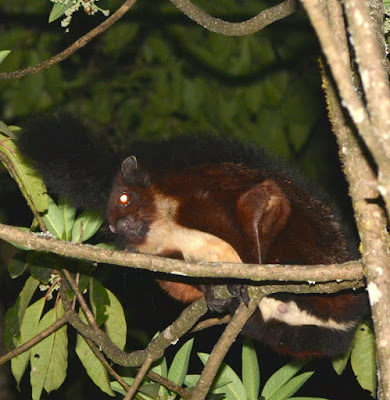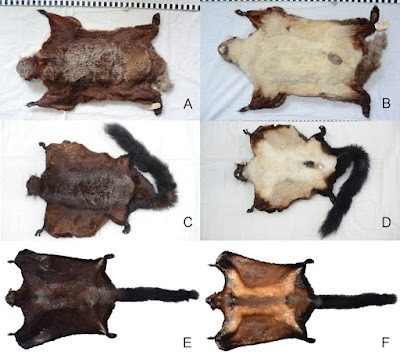[Most Recent Entries] [Calendar View]
Friday, July 19th, 2019
| Time | Event | ||||
| 9:05a | [Ornithology • 2019] Multiple Species within the Striated Prinia Prinia crinigera‐Brown Prinia P. polychroa complex revealed through An Integrative Taxonomic Approach Abstract We re‐evaluated the taxonomy of the Striated Prinia Prinia crinigera‐Brown Prinia P. polychroa complex using molecular, morphological and vocal analyses. The extensive seasonal, sexual, age‐related, geographic, and taxon‐specific variation in this complex has never before been adequately studied. As no previous genetic or vocal analyses focused on this group, misinterpretation of taxonomic signals from limited conventional morphological study alone was likely. Using mitochondrial and nuclear DNA, we found that P. crinigera sensu lato (s.l.) comprises two non‐sister groups of taxa (Himalayan crinigera and Chinese striata groups) that differ substantially morphologically and vocally, and that are broadly sympatric in Yunnan Province, China. Prinia polychroa cooki (Myanmar) and P. p. rocki (southern Vietnam) are each morphologically, vocally and genetically distinct. Thai, Cambodian and Laotian populations formerly ascribed to P. p. cooki are morphologically and vocally most similar to and most closely related to Javan P. p. polychroa, and require a new name, proposed here. Prinia p. bangsi of Yunnan is part of the crinigera group rather than of P. polychroa, and hence there is no evidence for sympatry between P. polychroa s.l. and P. crinigera s.l., nor of the occurrence of P. polychroa in mainland China or Taiwan. We recommend the recognition of five species in the complex, with the following suggestions for new English names: Himalayan Prinia P. crinigera sensu stricto (s.s.; with subspecies striatula, crinigera, yunnanensis and bangsi); Chinese Prinia P. striata (subspecies catharia, parumstriata and striata); Burmese Prinia P. cooki (monotypic); Annam Prinia P. rocki (monotypic); and Deignan's Prinia P. polychroa s.s. (subspecies Javan polychroa and the new Southeast Asian taxon). This study underscores the importance of using multiple data sets for the elucidation of diversity of cryptic bird species and their evolutionary history and biogeography. Keywords: Cisticolidae, Sylvioidea, biodiversity, phylogeography, vocalizations, systematics, DNA, morphology
Prinia polychroa deignani, subsp. nov. Distribution. Examined specimens of Prinia p. deignani are listed in Table 3 and Table S1, along with documented photographs and sound recordings. Based on these data, the new subspecies is confirmed to occur in scattered localities in northwest, central and eastern Thailand, southwestern Laos, and northwestern Cambodia. A sequenced specimen from Cambodia (NHMUK 1928.6.26.1198) is very similar in cyt b to the two sequenced Thai specimens. Etymology. We wish to honour Herbert Girton Deignan (1906 –1968) for his contributions to understanding of this complex specifically, and to Thai birds in general, by naming this new subspecies after him. CONCLUSIONS: Based on our integrative taxonomic approach, analysing morphology, songs, DNA and geographical distributions, we recommend recognition of five species in the Prinia crinigera s.l. - P. polychroa s.l. complex, and suggest the following English names : Himalayan Prinia P. crinigera s.s. (with four subspecies) ; Chinese Prinia P. striata (with three subspecies) ; Burmese Prinia P. cooki (monotypic); Annam Prinia P. rocki (monotypic) and Deignan’s Prinia P. polychroa s.s. (with two subspecies), as summarised in Table 1 . We found no evidence that P. polychroa s.l. or s.s. occurs in mainland China , Taiwan, or India, or that P. striata occurs in India. Acceptance of this revision implies the existence of two new single - country endemics: P. cooki from Myanmar, and P. rocki from Vietnam. Prinia striata becomes endemic to mainland China and Taiwan. We describe a new subspecies of P. polychroa s.s., from Thailand, Laos, and Cambodia. This study highlights the importance of taxonomic revisions of poorly studied polytypic birds using a modern integrative taxonomic approach to better estimate the true diversity of bird species. Per Alström, Pamela C. Rasmussen, George Sangster, Shashank Dalvi, Philip D. Round, Ruying Zhang, Cheng‐Te Yao, Martin Irestedt, Hung Le Manh, Fumin Lei and Urban Olsson. 2019. Multiple Species within the Striated Prinia Prinia crinigera‐Brown Prinia P. polychroa complex revealed through An Integrative Taxonomic Approach. Ibis. DOI: 10.1111/ibi.12759 | ||||
| 9:44a | [Mammalogy • 2019] Biswamoyopterus gaoligongensis • Discovery and Description of A Mysterious Asian Flying Squirrel (Rodentia, Sciuridae, Biswamoyopterus) from Mount Gaoligong, southwest China
Abstract The flying squirrels of the tribe Pteromyini (Family Sciuridae) currently include 15 genera of which the genus Biswamoyopterus comprises two recognized species, B. biswasi Saha, 1981 and B. laoensis Sanamxay et al., 2013. These two species were each described from only one specimen that are separated from each other by 1,250 kilometres in southern Asia, where they occur in northeast India and central Lao PDR respectively. In 2017 and 2018, two specimens of Biswamoyopterus were discovered from Mount Gaoligong, west Yunnan province, southwest China (between the type locality of the two recognized species). This study aimed to evaluate the taxonomic status of these two newly acquired specimens of Biswamoyopterus by comparing their morphology with the two described species of the genus. The results of this study showed that the specimens from Yunnan province (China) differed from both B. laoensis and B. biswasi in both pelage colour and craniology, and should be recognised as a distinct species, Biswamoyopterus gaoligongensis sp. nov., which is formally described here. This study contributes to the understanding of the flying squirrels of southern Asia and identifies an additional species that appears to be endemic to southwest China; however, more research is required to provide details of its ecology, distribution, and conservation status. Keywords: Biodiversity, conservation, mammal, Pteromyini, systematics, taxonomy, threatened, wildlife, Yunnan
Taxonomy Class Mammalia Linnaeus, 1758Order Rodentia Bowdich, 1821 Family Sciuridae Fischer, 1817 Subfamily Sciurinae Fischer, 1817 Tribe Pteromyini Brandt, 1855 Genus Biswamoyopterus Saha, 1981 Biswamoyopterus gaoligongensis sp. nov. Common name: Mount Gaoligong Flying Squirrel. Chinese common name "高黎贡比氏鼯鼠". Etymology: The specific name is derived from Mount Gaoligong, the type locality of the new species and –ensis, Latin for belonging to. Diagnosis: Biswamoyopterus gaoligongensis sp. nov. can be distinguished from the other two described species of Biswamoyopterus by the following combination of traits: 1) The ear tufts at the base of the posterior margins of ears are bicolored, basally white and terminal black. The scrotum is dark brown which strongly contrasts with the yellowish-white abdominal pelage. 2) The muzzle is very short, and the zygomatic arch is distinctly expanding outward, making the outline of the skull short and wide. The outer margin of the nasal bone, the orbital margin of the frontal bone, and the post-orbital margin of the frontal bone are almost parallel to the midline of skull on the dorsal view. The central point of the posterior margin of the palatal bones lies in front of the posterior margin of M3. 3) M1 and M2 are sub-square in outline, and as large as P4. The hypoconid of P4-M2 are very developed, strongly pointed towards posterior buccal side. Distribution: Apart from the locality of the holotype, there are two more localities in Yunnan, China, where the Biswamoyopterus gaoligongensis sp. nov. was photographed. These include Linjiapu, 10 km west of the type locality; and Banchang, 9 km south of the type locality (Fig. 1). Although these three localities cover the east and west slopes of Mount Gaoligong (the watershed of the Irrawaddy River and the Nu River [Salween River]), they are all restricted in a small area of southern Mount Gaoligong. Natural history: Little is known about the natural history of Biswamoyopterus gaoligongensis sp. nov. The holotype was collected from evergreen broad-leaved forest at an altitude of 2,000 meters above sea level. A set of photos taken in Linjiapu showed a Biswamoyopterus gaoligongensis sp. nov. resting on the branches of Daphniphyllum sp. Petaurista yunanensis, P. elegans, and Hylopetes alboniger were also collected in the same habitat where the holotype was collected. Quan Li, Xue-You Li, Stephen M. Jackson, Fei Li, Ming Jiang, Wei Zhao, Wen-Yu Song and Xue-Long Jiang. 2019. Discovery and Description of A Mysterious Asian Flying Squirrel (Rodentia, Sciuridae, Biswamoyopterus) from Mount Gaoligong, southwest China. ZooKeys. 864: 147-160. DOI: 10.3897/zookeys.864.33678 New species of flying squirrel from Southwest China added to the rarest and 'most wanted' |blog.pensoft.net/2019/07/18/new-species-o |
| << Previous Day |
2019/07/19 [Calendar] |
Next Day >> |
















